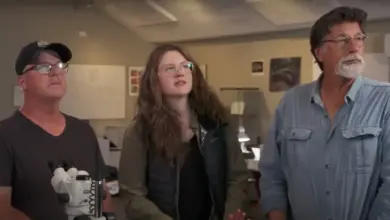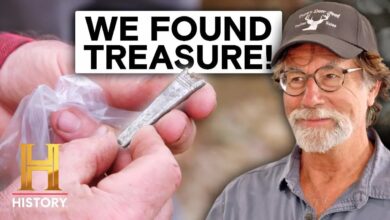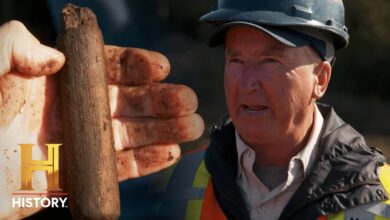Rick Lagina: “We Just Unearthed The Evidence We Needed To Solve The Mystery!”
Rick Lagina: "We Just Unearthed The Evidence We Needed To Solve The Mystery!"
Rick Lagina just hit the biggest jackpot of his life.
There’s a buzz on the island because it seems a lab in Queens, Ontario, has found a new way to detect gold in water.
Now, the whole team is wondering if this is even possible. Could this be the big break that leads to a fortune, just like what happened to treasure hunters Rick and Marty Lagina?
Let us explore the evidence that allows this miracle to take the Lagina family to a whole new level.
The Gold Hunt Continues
On this island, there seems to be an ongoing obsession with finding gold, and each small discovery is treated as if it might finally lead to something big.
Recently, there’s been some excitement over a lab in Queens, Ontario, that has offered to analyze water samples, claiming it can detect traces of gold.
This lab focuses on examining groundwater for gold mining companies, and their announcement has breathed new life into the local search efforts, despite longstanding beliefs that detecting gold in water was not feasible.
The hunt for gold here has been repetitive for over ten years, with each promising technique eventually leading to disappointment. Yet, with this new water testing method that claims to find gold in minuscule amounts, there’s a renewed sense of optimism.
It’s curious, though, how quickly everyone is ready to believe that we might be on the verge of a breakthrough, considering our history of dead ends.
The island’s waters, often muddy and stirred up from constant testing, are known to be full of minerals like iron and calcium. This isn’t news; it’s a well-established fact.
The recent tests claiming to have found gold in these waters have sparked a flurry of activity, but one has to wonder if these findings are genuinely significant or just another small detail in a long string of unproductive efforts.
The latest attempt to uncover something of value, the team focused on borehole DN 11.5, located in a region of the island humorously termed the ‘baby blob.’
There’s an expectation, maybe more a hope, that beneath 80 feet we might not only find something valuable but also intersect with a tunnel that has been rumored to exist under the garden shaft.
This area is particularly interesting because it’s where the supposed gold traces in the water were detected. As the drill reached a depth between 78 and 88 feet, everyone involved was on edge, anticipating that this time, just maybe, we’d find what we’ve been looking for.
Suddenly, at about 90 feet, the drill broke through into an open space. This moment was met with a mix of excitement and the usual skepticism—discovering a void is one thing, but confirming it as part of a significant underground structure is quite another challenge.
The next necessary step is to retrieve core samples. These samples are crucial; they represent the backbone of our investigative process, deciding whether we are about to uncover something truly valuable or simply adding to the extensive catalog of futile attempts.
This repetitive cycle of anticipation followed by disappointment has become all too familiar here. Despite this, the prospect of finally hitting pay dirt (literally and figuratively) keeps everyone motivated.
We’re not just digging for gold; we’re digging for answers, hoping that this time will be different, that this new lead will prove fruitful, and that all the years of effort will finally yield something substantial.
Yet, as we continue this quest, one can’t help but feel a bit skeptical. Are we really on the brink of a significant discovery, or are we just caught up in the excitement of another promising lead?
The search for gold here is about more than just finding precious metal; it’s about trying to validate all the years spent searching, to justify the continued efforts with something more tangible than yet another intriguing possibility.
As we dig deeper, each discovery hints at secrets waiting below.
Scientific Breakthroughs Underground
From a third-person perspective:
If a tunnel was discovered near the base of a shaft, it would certainly catch attention.
“Got it, there’s some wood here, Terry. We’ve found a ‘W’ at the bottom,” calls out an excited voice.
“Wow, we’re really onto something. I’ll just squeeze in and take a wood sample,” they decide, choosing a small piece for analysis.
“We’re quickly sending this to the lab to check for any metals in the wood.”
The X-ray fluorescence (XRF) results from sample DN 11.5 soon arrive.
“Great, this looks like a tunnel and it points towards the garden shaft. We might be onto something significant here,” someone remarks, prompting further investigation.
Just the day before, Emma had dried and examined the wood sample, thought to be from a tunnel about 90 feet deep, potentially linked to the Garden shaft.
She used a spectrometer emitting gamma rays to detect elements or metals.
“What are we seeing?” asks someone. Emma, examining the results, responds,
“We’re finding very small amounts of typical materials from our Oak Island site: iron, manganese, titanium, calcium, potassium, aluminum—these are all common here.”
She reassures the team as anticipation builds.
“However, we are also finding traces of gold,” she adds, catching everyone’s attention with the mention of gold.
The discovery of even minute amounts of gold excites and fuels speculation among the team. The analysis of the wood, along with previous water tests, suggests a potentially significant trail of findings for the season.
“This could mark the beginning of a significant discovery trail, as important as any water tests we’ve conducted so far,” they muse, cautiously hopeful.
The advice remains: “You don’t find samples here; this lab is for figuring out tough answers.”
Their ongoing scientific exploration, with a hint of showmanship, continues to generate both skepticism and expectation.
So, the collection of more samples begins. Just as they start setting up the drilling equipment, Alex arrives—perfect timing, as usual—right when they are about to dig deeper in hopes of a significant discovery in the garden shaft.
Today is more than just another day of digging; it feels like the verge of a major breakthrough.
Collecting soil samples is standard when searching for hidden treasures. But today is different, Alex points out, focusing on the old, tightly packed wooden lining from the shaft.
He insists on preserving every piece from each drilled hole for later analysis. With an XRF machine back at the lab ready to examine potential gold traces, the team theorizes that the wood, soaked through years of exposure, might reveal hints of gold.
Their approach? Test everything. If gold was carried through the shaft by water, then the wood, absorbing like a sponge, could also show signs of gold.
With evidence in hand, they delve deeper into the mystery, eager to uncover more.
The Money Pit’s New Chapter
Suddenly, the rest of the team arrives, just in time to get stuck into the work.
“The gang’s all here,” someone shouts as we gather around the latest findings. And what’s this someone brought along? A crown, of all things.
A touch of humor, perhaps, or a nod to what we might find? And here comes Emma, with updates ready to share.
You gave her a small piece of wood, perfect for a detailed scan, which our equipment can easily handle.
What are we staring at, then? That piece of wood comes from the lining of the garden shaft—a section of the structure that has likely witnessed decades, if not centuries, of history.
Emma’s findings will hopefully tell us more. Are we looking at mere wood, or does it carry traces of a golden past?
Each piece we examine, every sample we scrutinize, adds another layer to our understanding. We’re piecing together a puzzle, but with each piece comes new questions.
Are we about to strike gold, or are we just chipping away at old dreams? This relentless pursuit, this blend of scientific rigor and hopeful anticipation, drives us forward.
We’re not just digging holes; we’re seeking clues left by the past, hints embedded in wood and water.
Maybe today we’ll uncover something monumental, or maybe we’ll just find more questions that beg for answers.
Either way, the thrill of the hunt keeps us going, drilling deeper, exploring further. Who knows what tomorrow’s drill might reveal? Only time, and perhaps a few more holes, will show us what lies beneath.
The well-known Money Pit area, where many have searched again and again, a new claim has been made, this time involving the exciting discovery of gold.
Emma Culligan, an expert in metals, confidently shares her findings with colleagues who are used to hearing big claims with little payoff.
“I confirmed it,” she declares, clearly pleased. “There’s definite gold in the wood samples taken two days ago from 55 feet deep in the garden shaft.”
Normally, such claims are met with skepticism, but her assertion brings a rare silence to the room.
Emma isn’t talking about just a tiny speck of gold; her tests show a substantial amount of gold mixed in with the wood.
She backs up her claim with a bold statement: “100% accuracy.” The idea that there might actually be something valuable there feels both exciting and heavy with potential.
This isn’t another layer of hype that often surrounds this place—it’s a measurable, confirmable fact. The presence of gold, even a small amount, is a big deal.
“It’s still significant,” she quickly adds, sensing the doubts creeping in. “Even one percent is enough.”
The veterans in the room exchange glances, their expressions a mix of hope and skepticism.
What happens next could be seen as either a tribute to human persistence or a recurring act in a long-running drama that this place always seems to put on.
The team leans in, their faces a blend of hopeful anticipation and the tough realism




